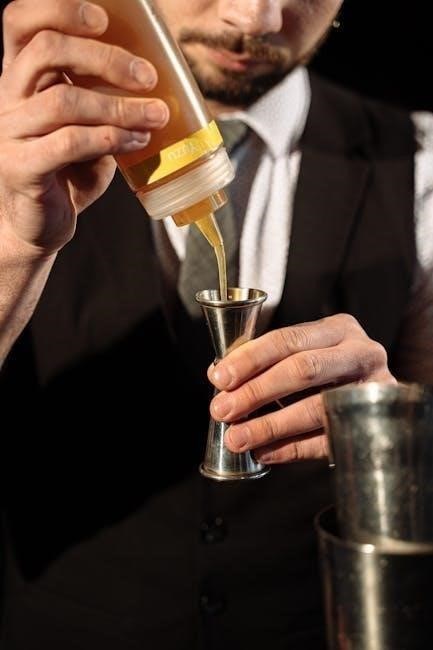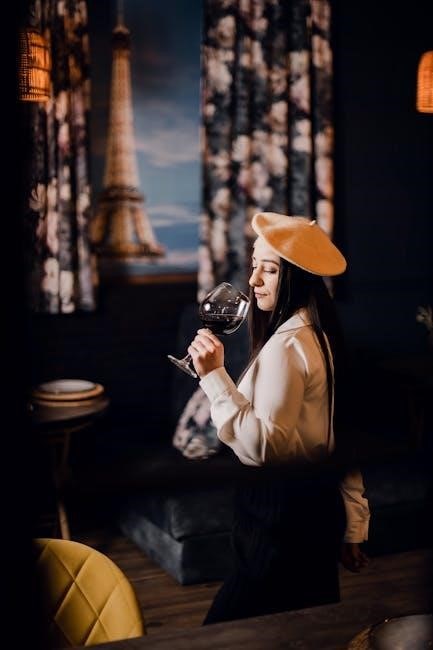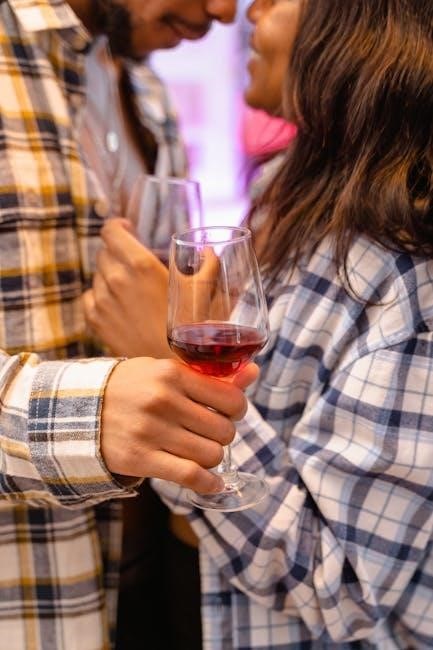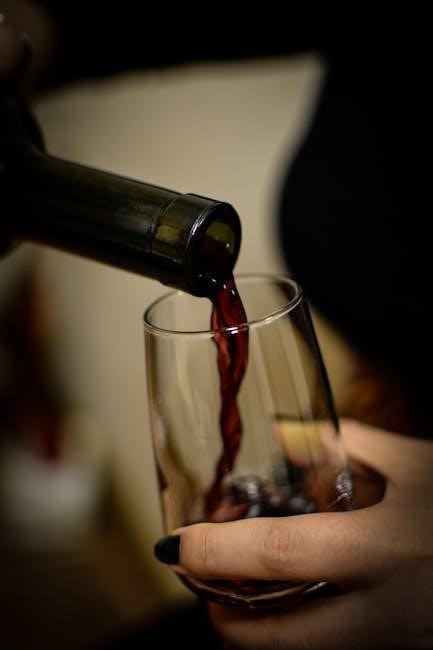Welcome to the world of wine, a journey of discovery and flavor. Wine offers a rich tapestry of tastes, cultures, and traditions, perfect for beginners to explore and enjoy.
Why Wine is a Great Beverage for Beginners
Wine is an excellent choice for beginners due to its variety and accessibility. With options like white, rosé, red, sparkling, and dessert wines, there’s something for every palate. It’s also affordable, with quality bottles available at modest prices. Wine pairs well with many foods, making it versatile for meals or casual sips. Additionally, resources like tasting guides and pairing tips make it easy to start your journey. Wine is a rewarding beverage that combines flavor, culture, and enjoyment, perfect for newcomers to explore.
Setting Expectations for Your Wine Journey
Embrace your wine journey with an open mind and patience. Wine tasting is subjective, so trust your palate and explore gradually. Start with affordable, approachable wines to discover your preferences. Learning about grape varieties, regions, and pairing basics will enhance your experience. Remember, wine appreciation is a lifelong journey. Enjoy the process, experiment with different styles, and don’t hesitate to seek advice from experts or online guides. Every sip is a step toward deeper enjoyment and understanding.

Understanding the Basics of Wine
Wine is crafted from specific grape varieties, with types like red, white, rosé, sparkling, and dessert. Regions and winemaking techniques shape its flavor and character.
Types of Wine: Red, White, Rosé, Sparkling, and Dessert
Red wines, like Cabernet Sauvignon, are bold and tannic, pairing well with hearty dishes. White wines, such as Chardonnay, are crisp and refreshing, ideal for lighter meals. Rosé wines offer a fruity and elegant choice for casual sipping. Sparkling wines, like Champagne, add celebration to any occasion. Dessert wines, such as Moscato, are sweet and perfect for ending meals. Each type caters to different tastes and settings, making wine versatile for every preference and moment.

Popular Grape Varieties Every Beginner Should Know
For beginners, familiarizing yourself with key grape varieties is essential. Cabernet Sauvignon, known for its bold flavors, is a popular red wine choice. Merlot offers smooth, fruity notes, making it approachable. Chardonnay, a buttery and oaky white wine, is widely enjoyed. Sauvignon Blanc stands out with its crisp, citrusy profile. Pinot Noir, a light-bodied red, is perfect for those preferring delicate flavors. These varieties provide a solid foundation for exploring the diverse world of wine and understanding your personal preferences.

Essential Tools for Wine Drinking
A wine decanter enhances flavor by aerating the wine, while a corkscrew is indispensable for opening bottles. These tools elevate your wine-drinking experience and simplify the process.
The Importance of Wine Glasses
Wine glasses are essential for enhancing the drinking experience. Their shape directs the aroma to the nose and the wine to the correct part of the tongue, balancing flavors. Red wine glasses have a larger bowl for bold flavors, while white wine glasses are narrower to preserve crispness. Sparkling wine flutes prevent carbonation from fading. Investing in quality glasses elevates your appreciation of wine, making it a worthwhile investment for any beginner.
How to Use a Wine Opener
Using a wine opener is a straightforward process that enhances your wine-drinking experience. For a corkscrew-style opener, place the tip in the center of the cork, twist it in gently, and pull straight up. For a lever-style opener, attach the device to the neck of the bottle, tilt the lever to remove the cork, and pour. Always handle the cork carefully to avoid breaking it into the wine. Proper use ensures the wine remains intact and ready to enjoy.
Wine Aroma Wheel: A Beginner’s Guide
A wine aroma wheel is a tool designed to help identify and describe the scents in wine. It categorizes aromas into broad groups like fruity, floral, earthy, and spicy, with finer distinctions within each category. Beginners can use the wheel to pinpoint what they smell, enhancing their tasting experience. Start by swirling the wine to release its aromas, then refer to the wheel to match what you detect. This visual aid simplifies the process of describing complex scents, making wine tasting more accessible and enjoyable for newcomers.

Wine Tasting Techniques
Mastering wine tasting involves observing appearance, swirling to release aromas, and sipping to experience flavors. Use tools like aroma wheels and tasting steps to enhance your journey.
The Five Steps of Wine Tasting
Wine tasting involves five key steps: look, swirl, smell, taste, and finish. Start by observing the wine’s color and clarity. Swirling releases aromas, while smelling reveals its bouquet. Tasting involves sipping and assessing flavors. Finally, the finish is how long the flavors linger. These steps help deepen your appreciation and enhance your wine-drinking experience, making each sip more enjoyable and meaningful for beginners and experts alike.
Common Wine Descriptors for Beginners
When describing wine, beginners often use terms like fruity, crisp, smooth, tannic, oaky, and sweet. These words help convey the wine’s taste and aroma. Fruity wines highlight flavors of berries or citrus, while crisp wines feel refreshing. Tannic wines have a drying sensation, often found in reds. Oaky notes suggest aging in barrels, adding vanilla or caramel hints. Understanding these terms helps you communicate preferences and enhance your wine-drinking experience.

Pairing Wine with Food
Wine and food pairing enhances dining experiences by matching flavors and textures. Start by pairing wine with the main dish, considering its sweetness, acidity, and tannins for harmony.
Basic Principles of Wine and Food Pairing
Understanding wine and food pairing starts with matching complementary flavors. Sweet dishes pair well with sweet wines, while savory foods align with dry varieties. Acidity in wine enhances bright, fresh flavors, while tannins balance fatty or rich dishes. Pairing by region is another approach—Italian wines with Italian cuisine, for instance. Consider the main ingredient in a dish and choose a wine that complements its texture and flavor profile. This balance creates a harmonious dining experience, elevating both the food and the wine.
Simple Wine Pairing Ideas for Everyday Meals
Start with Chardonnay for roasted chicken or buttery pasta, while Pinot Noir complements lighter dishes like salmon or salads. Merlot pairs well with red meat or hearty stews. For seafood, try Sauvignon Blanc with its crisp acidity. Rosé is perfect for spicy or Mediterranean meals. Remember, personal taste matters—experiment to find your preferences. Affordable wines like a $10 red can offer great value. Keep it simple and enjoy the journey of discovering your ideal pairings!

Budget and Shopping Tips
Wine doesn’t have to be expensive. Great options exist around $10, offering excellent value. Shop at local stores or online for variety and deals. Consult staff for recommendations to find wines that suit your taste without breaking the bank.
How to Choose Good Wine on a Budget
Choosing good wine on a budget is easier than you think. Look for wines priced between $10-$15, which often offer great quality and value. Consider lesser-known regions or grape varieties, as they can be more affordable. Store staff or online reviews can help you discover hidden gems. Don’t shy away from asking for recommendations, and keep an eye out for sales or discounts. Remember, expensive doesn’t always mean better—trust your palate and explore options within your budget.
Where to Buy Wine as a Beginner
As a beginner, you can start by exploring wines at local supermarkets, wine shops, or online retailers. Many stores offer staff recommendations or labels indicating good value. Farmer’s markets and vineyards are also great places to discover wines. Online platforms like wine subscription services or community forums can provide reviews and guidance. Don’t hesitate to ask for help—store staff are often knowledgeable and happy to assist you in finding the perfect bottle within your budget.
Common Mistakes to Avoid
Overcomplicating wine choices, neglecting proper serving temperatures, and swirling excessively are common mistakes. Avoid rushing the tasting process and focus on enjoying the experience.
Mistakes Beginners Make When Drinking Wine
Beginners often overlook the importance of proper wine storage, serving temperatures, and pairing. They might also swirl excessively or rush the tasting process. Avoiding these mistakes enhances the experience. Correcting these errors ensures better flavor appreciation and enjoyment. Learning from these common pitfalls helps refine your wine journey and makes every sip more satisfying and memorable. Embrace the learning process and enjoy the journey of discovery. Wine is a journey, not a race, so savor each moment. Proper techniques and patience lead to a more fulfilling experience.
How to Store Wine Properly
Proper wine storage preserves its quality and flavor. Keep bottles in a cool, dark place with consistent temperatures between 10-15°C. Avoid direct sunlight and heat sources. Maintain humidity levels to prevent cork drying. Store bottles on their side to keep the cork moist. Use a wine rack or cellar for optimal conditions. Avoid strong-smelling areas, as odors can seep into the wine. Proper storage ensures your wine ages gracefully and remains enjoyable for years to come. Always handle bottles gently to prevent agitation.
Exploring Beyond the Basics
Expand your wine knowledge by exploring new regions, grape varieties, and winemaking techniques. Join wine communities, attend tastings, and experiment with different wines to enhance your journey.
How to Expand Your Wine Knowledge
Expanding your wine knowledge involves exploring different regions, grape varieties, and winemaking techniques. Start by reading wine blogs, joining online forums, and attending local wine tastings. Experiment with wines from various countries to understand their unique characteristics. Consider enrolling in a wine course or using apps that guide you through tasting notes and pairing tips. Visiting vineyards and talking to winemakers can also deepen your understanding. Remember, wine is a journey, so embrace curiosity and keep exploring new styles and flavors.
Joining Wine Communities and Events
Engaging with wine communities and attending events is a fantastic way to enhance your wine journey. Online platforms like Reddit’s r/wine offer valuable insights and discussions. Local wine tastings, vineyard tours, and wine festivals provide hands-on experiences. These events allow you to meet fellow enthusiasts, learn from experts, and discover new wines. Participating in workshops or webinars can also deepen your knowledge. Joining a community fosters camaraderie and accelerates your learning, making wine exploration more enjoyable and rewarding.
Embrace the journey, savor each sip, and enjoy the endless possibilities wine offers. Cheers to your continued discovery and pleasure in the world of wine!
Final Tips for Enjoying Wine
Experiment with varieties to find your palate. Store wine properly to preserve quality. Pair wines with simple dishes for everyday meals. Don’t overlook affordable options—great wines can be found at $10. Engage with wine communities for inspiration. Remember, wine is a journey of discovery, so relax, have fun, and cheers to your adventure!
